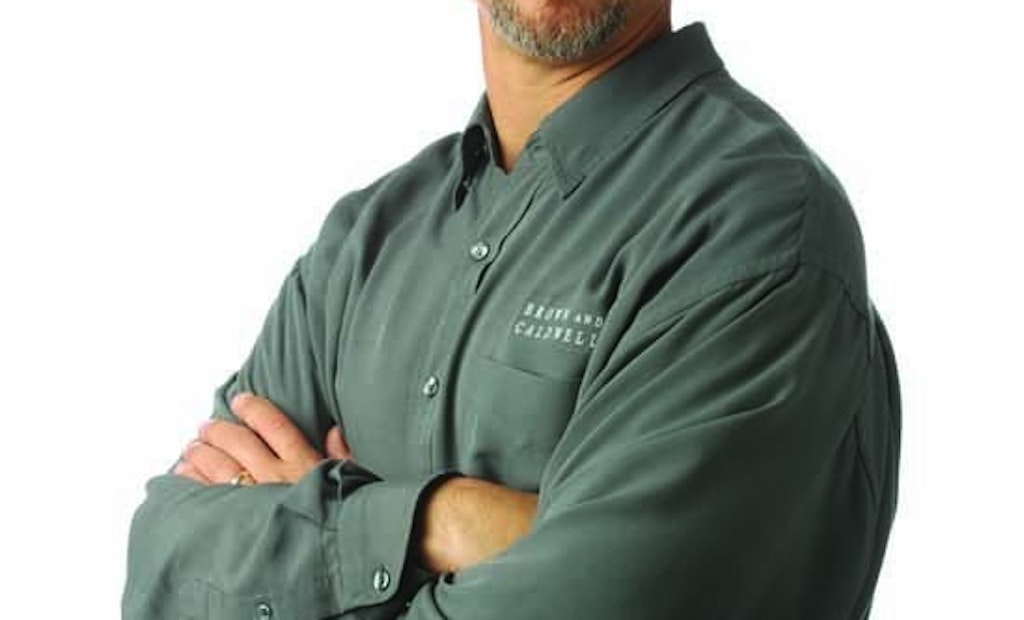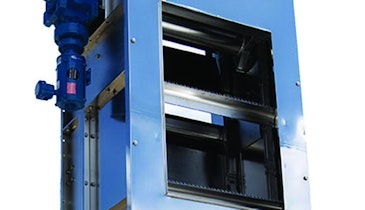Interested in Energy?
Get Energy articles, news and videos right in your inbox! Sign up now.
Energy + Get AlertsIn a time when resource recovery is a top priority, clean-water agencies increasingly look for biogas and biosolids solutions that are economical yet sustainable.
In the view of John Willis, P.E., those two attributes go hand in hand a large share of the time. Willis, a vice president with the Brown and Caldwell engineering and construction firm, was elected to the Water Environment Research Foundation Research Council for a three-year term that began in April 2016.
A nationally recognized expert in biosolids and biogas-to-energy, Willis has worked for 25 years helping utilities combat inefficiency and make the maximum use of energy. He has done significant work in areas that include thermophilic anaerobic digestion and innovative biogas-to-energy upgrades. He has also done work on thermal hydrolysis, digestion and biogas usage for agencies including DC Water, the Hampton Roads (Virginia) Sanitation District, and the City of Raleigh, North Carolina.
Willis has served as principal investigator for several WERF research programs, including Barriers to Energy Efficiency, Barriers to Biogas Use, Undocumented Sources of Methane from Wastewater Treatment and Conveyance, and others. He was also principal investigator for the U.S. EPA Technology Evaluation for Digester-Gas-Fueled Combined Heat and Power and serves as chairman of the Water Environment Federation’s Bioenergy Subcommittee.
Willis, who works out of Brown and Caldwell’s Atlanta office, holds a master’s degree in environmental engineering from Duke University and is finishing work on a doctorate from the University of Queensland in Brisbane, Australia. He talked about the current state of the art in biogas and biosolids, and what the future holds, in an interview with Treatment Plant Operator.
TPO: What makes you a good choice for a position on the WERF Research Council?
Willis: I’ve been principal investigator on several WERF projects and have been a project team member on another 15 or so. I’m very passionate that as an industry we can do a lot better job than we are today at all sorts of things, whether it’s doing things with less energy or with lower greenhouse gas impact. There are win-win-wins all over the place if we approach some of the key questions differently. The Research Council has opportunities to generate projects that create high value for the industry.
TPO: In terms of resource recovery, and specifically biogas, what do you see as the obstacles to more development of energy projects?
Willis: There are two economic barriers, and they actually amount to the same thing. One is that the utility only has a certain amount of capital and they have to spend it on something else, like a consent order or a capacity expansion. The other is that people don’t think there’s a good enough return on investment. Often, when presented with an opportunity to save money, a utility will say, “We need a five-year payback.” That’s not sustainability-minded, and it doesn’t really look at the upside. The question ought to be, “Is this likely to make my rates lower over the next 20 or 30 years, after the project has been completely paid for?”
TPO: What’s the issue in thinking in terms of simple payback in some number of years?
Willis: The biggest problem with simple payback is that people can set an arbitrary “go” threshold. If a project has a 13-year payback, they can say, “Well, I need 10 years.” If it instead has a seven-year payback, they can say, “I need five.” If that bar is allowed to move, then anybody can kill the project by creating a higher bar.
TPO: Are there any barriers in terms of the technical aspects of, say, knowing how to run a combined heat and power (CHP) system?
Willis: I don’t think in general that’s a barrier. A bigger issue is that producing power is not part of most wastewater utilities’ core business. Taking on a new obligation to keep something running that doesn’t help their effluent quality — that seems to be a bigger barrier.
TPO: What are some promising developments in biogas and energy production that you see coming down the road?
Willis: In terms of biogas, one of the coolest things that everybody should be looking at is vehicle fuel — pulling out the CO2, pulling out all the contaminants, compressing the gas and putting it into buses or sanitation trucks. There is a huge economic upside to this.
TPO: Why is there more upside to vehicle fuel than to CHP at the plant?
Willis: Vehicle fuel is not the best solution for everyone. But while CHP is good, you need to treat the gas to a high level to put it into today’s engines, and then you need to run the engines. Vehicle fuel systems can be about half as expensive from a capital perspective, and they cost less to run because you don’t have the engine. And the revenue can be a lot better. About half of the revenue comes from replacing fuel in vehicles, while the other half is the petroleum industry’s payments to meet their renewable portfolio standards.
Under the EPA’s Renewable Fuel Standard (RFS), petroleum companies need to account for a certain amount of renewable fuels of various types for every gallon of fossil fuel they produce.
The RFS came into being in 2006, and ever since then the EPA has been running with it and making sure that renewable fuel credits (Renewable Identification Numbers or RINs) get bought. The renewable fuel credits are worth as much as the fuel itself, and so wastewater utilities can double how much money they get per gallon of biogas-derived vehicle fuel.
TPO: Where is this being done today?
Willis: San Antonio has a plant that takes the digester gas, produces pipeline-quality natural gas, and puts that into the distribution line. Brown and Caldwell put a gas-upgrading system in at one of the plants in King County, Washington, that has been running since the mid-1980s. We’re doing a project now with St. Petersburg, Florida, for vehicle fuel. It will produce the energy equivalent of 1,700 gallons of diesel every day. It works because the city is converting its trash truck fleet over to compressed natural gas. The project has a $90 million construction project, but over 20 years, after paying back the capital, it will save between $30 million and $60 million.
TPO: What about co-digestion to boost biogas production and generate more energy?
Willis: Co-digestion is exciting and we ought to be doing more of it. If you think of what we typically treat in digesters, it’s once-digested food waste. If we take in raw food waste and digest it, we get a lot more fuel value. We get what we normally would from the sludge, and we also get what the human body would have taken out. It’s a high-Btu feedstock.
But for co-digestion to have value, you have to be using the gas. Looking at the other side of the question, the State of Massachusetts has banned food waste from landfills. So far they haven’t enforced it, but if they did, then the food waste producers and solid waste haulers would have to find something to do with the food waste. So there may be a revenue stream for treatment plants accepting that material. That kind of tipping-fee revenue has driven many co-digestion projects.
TPO: What else on the biogas side is exciting right now?
Willis: I think the DC Water program is a new paradigm. A lot of utilities are looking at thermal hydrolysis. That’s a pretty neat technology. It creates a lot less of a better biosolids product that dewaters better. It helps reduce the cost, and it also allows more diverse uses. There isn’t as much “yuck factor.” There is a considerable product upside.
TPO: Do you see any more futuristic technologies in the developing stages?
Willis: There’s a company called Kore Infrastructure that’s looking at turning sludge into diesel, using a process called hydrothermal liquefaction. It takes energy and equipment to do that. I’m not sure it’s entirely perfected yet, but what if instead of producing biosolids we could produce diesel? There’s a spinoff from one of the Stanford University research groups called Mango Materials. They are using a similar high-temperature process to form fundamental carbon molecules that can be used to produce plastics.
TPO: Looking at the biosolids side, what do you think can be done about the horror stories that continue to be told about land application?
Willis: The industry and the EPA have done everything we possibly can to document that land application is safe, but we can’t prove a negative. It’s pretty tough to prove that it’s absolutely, positively safe, even though everything we’ve done says the risks are virtually nonexistent. It’s a public relations machine that generates the misinformation, and it just keeps cranking. I think we need to routinely tell the public about all the good we’re doing as an industry. We ought to be willing to call our newspapers and get that message out there. Many of us still have the attitude of “Let’s keep our heads down and hope the newspapers don’t call.” That’s shortsighted. Where biosolids are concerned, we ought to be talking about how good what we already do is.
TPO: Is there anything new under the sun in Class A biosolids products that are more readily accepted in the public arena?
Willis: I have been involved in a number of thermophilic digestion projects. I’m excited about the ability to create products that people will pay for, whether that’s as simple as a dried product or composted materials and pelletized products. I think the biggest opportunity lies in putting material on a train and taking it to places where it’s needed, such as the Midwest, where there is an abundance of farmland and relatively few people. That’s a completely untapped market. There are farmers working 10,000 acres who have never heard of biosolids. That’s just wrong. There has to be a business model that can make that work.
TPO: Where do you see the WERF Research Council heading?
Willis: It’s an exciting time. We’ve done dramatically more in the last five years than we did in the previous five to 10. That needs to keep going. There are many places where we can do better: efficiency, other biosolids products, better ways of processing solids, better ways of saving costs. Every time I looked at one of these areas, I find that getting green and being sustainable actually can save a lot of money. There is really good alignment between being more sustainable and reducing life cycle cost.
I often find also that the best economic approach tends to be the most sustainable from a greenhouse gas perspective, too. DC Water’s biogas program saves $28 to $33 million a year in operating costs — it also reduces their carbon footprint by 35 percent. I think those kinds of opportunities exist everywhere, but we’re just not looking for them hard enough. WERF is essential to the job of doing wastewater treatment better. It’s a question of figuring out how to do it and how to make better decisions at the utility level.






